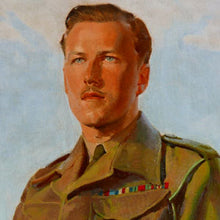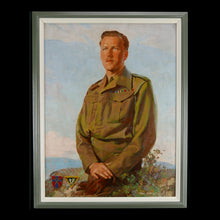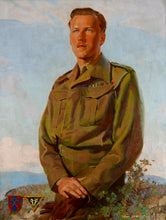Paul Van Jones - A Self Portrait, 1945
- Regular price
- £2,200
- Sale price
- £2,200
- Regular price
-
- Unit price
- /per
Adding product to your cart
Overall: 61.5cm (24.4in) x 50cm (19.7in)
Oil on Board. Three quarter length self portrait in battle dress, with the insignia of the 21st Army Group and the 79th Armoured Division lower left. Signed lower right ‘’.
The 79th Armoured Division was the specialist armoured division created during the Second World War as part of the preparations for the Normandy invasion of 6 June 1944 - D-Day. It was commanded by the outspoken ‘wizard of tank warfare’ Major-General Percy Hobart who had led the development of armoured tactics in the 1930s until sacked in 1939. In the dark days of late summer 1940, ‘Hobo', then a corporal in the Chipping Campden Home Guard was summoned to lunch by Prime Minister Churchill and reinstated with responsibility for the development of armoured vehicles to tackle many problems of the amphibious landing on the defended French coastline. The division’s unusual-looking tanks aka ‘Hobart's Funnies’ included tanks that floated, could clear mines, destroy defences, carry and lay bridges, and roadways. Its vehicles were distributed as small units across the divisions taking part in the landings and subsequent operations. The 79th Div remained in action during the North West Europe Campaign, providing specialised support during assaults to the 21st Army Group and, occasionally, to American units. They were of significant use during the Rhine crossings. Frustratingly it is unknown what role if any the subject of the present portrait played in 79th Armoured Division.
Paul Van Jones (1894-1966) was born at Bishopstoke, Hampshire, the son railway engineer. At the 1911 census he described himself as an ‘arts and crafts student’, and was also trained in architectural drawing. By the mid 1920’s he was working as a commercial artist and illustrator in various mediums. He worked extensively for the Surrey brewer Friary, Holroyd & Healy's Ltd, producing advertising material and pub signs and posters for its 400 tied houses. He designed travel posters including 'The Zoo By Tramway To Camden Town’ (1925) for the London County Council Tramways, and a Berwick-on-Tweed travel poster for London North East Railway (1941). In 1932 his watercolour of the grounds of Glamis Castle was selected by the Duchess of York (later Queen Elizabeth the Queen Mother) as her Christmas card for that year. He worked for the illustrated paper The Sphere (1933), and American Vogue. In 1939 he won a commission from the high street retailer Marks & Spencer to produce a series of paintings depicting the history and development of M&S one of which still hangs in the Board Room today; the paintings cover the period from 1895-1935. In December 1939 he submitted work to Kenneth Clarke’s War Artists Advisory Committee. After the War he moved his family to Kingston, South Devon where he set up a studio in a converted hayloft right under the thatch of his cottage roof. Here he produced portraits and landscapes and could be seen walking around the village with easel and umbrella resting on his shoulder with a bottle of his favourite beer hanging from the end.






